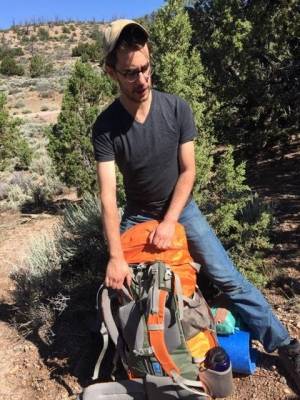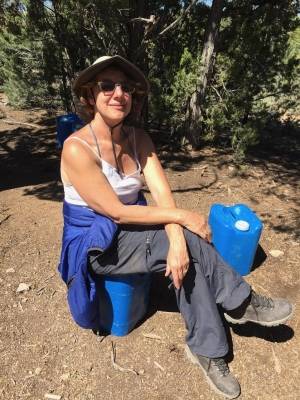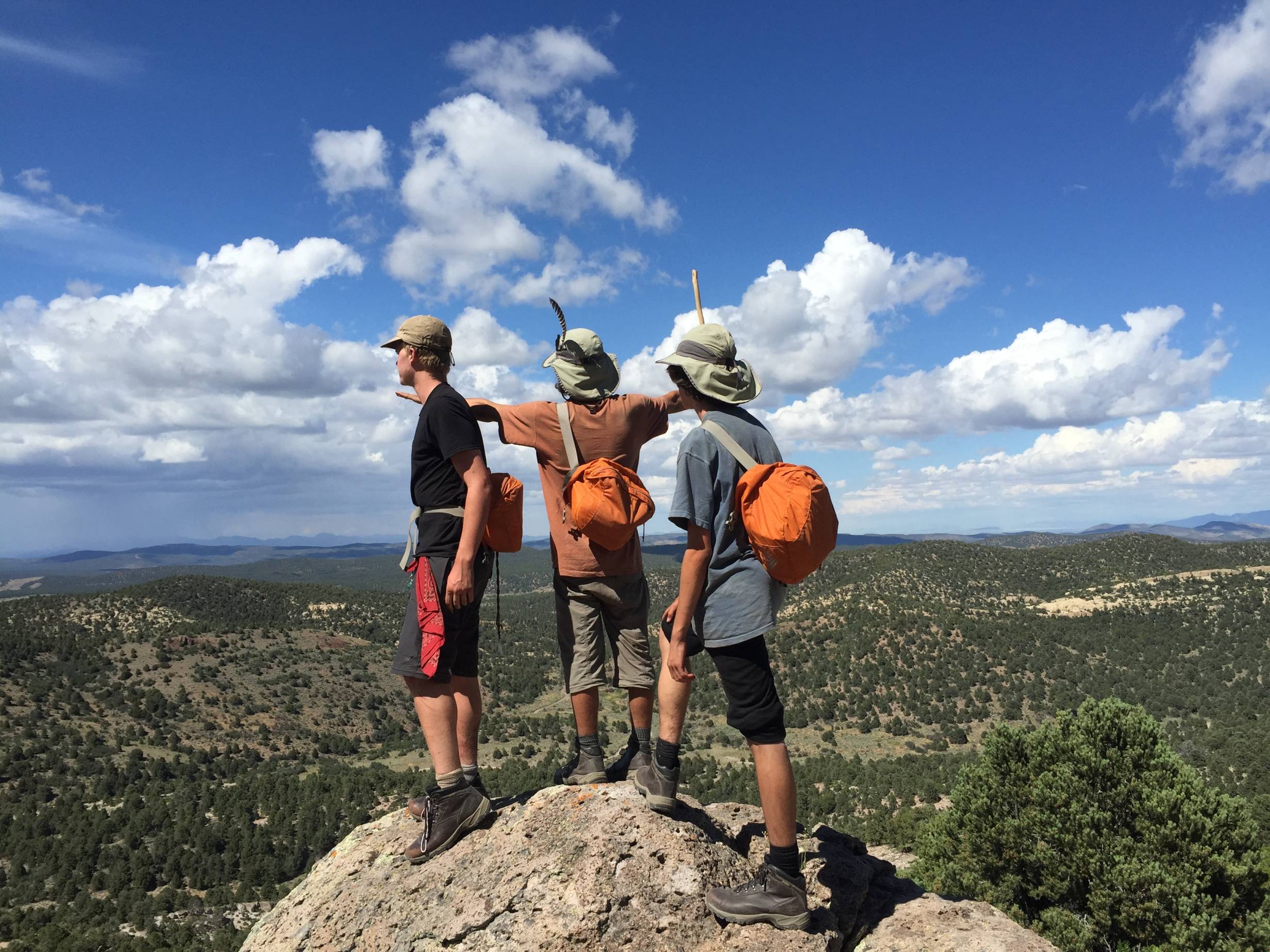En Garde Arts is a company which started out doing “site-specific theatre” in New York City during the 90s. The performers used different public locations as the backdrop for their scripts. These days, En Garde is bringing the reality with them as they tour with a multi-media production that incorporates live acting, singing and dance with real Skype phonecalls and video footage of Utah. The theme of the production centers around a half-dozen kids and their counselors at a wilderness camp. Those kids all have diagnoses of mental illness, some of the counselors are LCPCs, and the camp is an immersive effort to create a positive environment where they can begin to make the changes in their lives which are necessary to move toward healing and growth.
The docu- part of this play is that the experience exists, and the founder of En Garde Arts, Anne Hamburger, realized the story needed to be told after she sent her son. She collaborated with Chicago playwright Seth Bockley, who also directs the performances. I was lucky enough to get a few emailed questions in to each of these talents.
SP: I’m curious how the labor is divided. I know both Ann and Seth went to Utah for research and co-wrote the play, and that Seth is the stage director. But would you mind giving me a quick rundown of who did what in the birth of the production?
 Seth Bockley: We had a deeply collaborative process— the ‘gestation’ of the work started with Annie and her idea to take the tools and approach from our last work, Basetrack Live, and apply them to the topic of wilderness therapy. Annie conducted the primary interviews with the kids and parents via Skype, and then she and I worked together to edit the transcripts of those interviews into a rough draft. We also scheduled a trip to Utah in which we both took copious notes on every aspect of the wilderness therapy experience— as well as photos and video that are ultimately used in the production’s video design. At the same time as we developed the script, we were both exploring music– Annie made contact with two musicians who ultimately contributed original songs to the production. I worked on concepts for choreography and video design, so directorial ideas informed the script development even in our earliest phases. We made a breakthrough when I wrote the first dramatized scene—we realized that we had to break with a strict documentary approach and bring some of the wilderness scenes to life through dialogue. Each of the dramatized scenes in the play is based on a story we heard from one of the interview subjects or that we personally witnessed in the field. Finally, Annie began work on the character of the “Mom”, a pseudo-autobiographical figure who is in part based on Annie’s own experiences. So we put all that together and assembled drafts of the play through workshops at Pace University in New York, and then at the University of Florida, in preparation for our premiere at Abrons Arts Center in New York.
Seth Bockley: We had a deeply collaborative process— the ‘gestation’ of the work started with Annie and her idea to take the tools and approach from our last work, Basetrack Live, and apply them to the topic of wilderness therapy. Annie conducted the primary interviews with the kids and parents via Skype, and then she and I worked together to edit the transcripts of those interviews into a rough draft. We also scheduled a trip to Utah in which we both took copious notes on every aspect of the wilderness therapy experience— as well as photos and video that are ultimately used in the production’s video design. At the same time as we developed the script, we were both exploring music– Annie made contact with two musicians who ultimately contributed original songs to the production. I worked on concepts for choreography and video design, so directorial ideas informed the script development even in our earliest phases. We made a breakthrough when I wrote the first dramatized scene—we realized that we had to break with a strict documentary approach and bring some of the wilderness scenes to life through dialogue. Each of the dramatized scenes in the play is based on a story we heard from one of the interview subjects or that we personally witnessed in the field. Finally, Annie began work on the character of the “Mom”, a pseudo-autobiographical figure who is in part based on Annie’s own experiences. So we put all that together and assembled drafts of the play through workshops at Pace University in New York, and then at the University of Florida, in preparation for our premiere at Abrons Arts Center in New York.
SP: In my reading about En Garde Artes, I was really intrigued by your concept of site-specific theatre. It seems as though, with your docu-play format, you’ve found a more flexible & mobile way to influence theatre with the static, real, environments that exist in our world. Can you talk about what inspired the change between styles, and why you’ve chosen this blend of dramatic and realistic?
 Anne Hamburger: I don’t really feel I’m changing styles but rather enhancing and deepening the original vision. I am motivated by the exploration of contemporary forms of storytelling, whether through combining various media, dance and music as in Wilderness of bringing work to a site. My motivation for site-work was always centered around the ability this gave me to reach into new communities and engage them. With a show in the meat-packing district it was the people that worked and lived in this neighborhood. With wilderness, it is people who are affected by mental health issues, either personally or in their families. By the way, I believe this is almost everyone!
Anne Hamburger: I don’t really feel I’m changing styles but rather enhancing and deepening the original vision. I am motivated by the exploration of contemporary forms of storytelling, whether through combining various media, dance and music as in Wilderness of bringing work to a site. My motivation for site-work was always centered around the ability this gave me to reach into new communities and engage them. With a show in the meat-packing district it was the people that worked and lived in this neighborhood. With wilderness, it is people who are affected by mental health issues, either personally or in their families. By the way, I believe this is almost everyone!
SP: NAMI agrees with Anne, citing a statistic of 1 in 5 adults having a mental illness, whether diagnosed or not. It would be hard to find someone who didn’t have personal experience.
That makes me wonder if you also seek collaborators and actors who have similar experiences, or if you think the project naturally attracts those who have been affected and want to help? Has sharing experiences been part of the character-building or rehearsal process?
Hamburger: I sought out Seth because we forged a wonderful collaboration on Basetrack and I was confident that this partnership could yield fruit. Seth is a multi-dimensional artist who can both write and direct. He has both a musical and visual sensibility and is a great collaborator. Lastly, he is willing to dig in over time to investigate and uncover materials in service of a show’s creation. These are qualities that are of infinite importance and supersede an artist having similar experiences. That said, Welker White, the actress who plays the mom, has also sent her child to a wilderness therapy program and I reconnected with her in a parent support group. We had first met in the 90s through the downtown theatre community.
Bockley: We worked initially with undergraduate actors from Pace University to develop this show. Some of those initial actors are still with the production (they have all since graduated). I am certain that some if not most of the actors have encountered mental illness either in their own lives or with loved ones. However, I deliberately chose to leave the decision to share these experiences up to the individual. Rather than sharing personal experiences with the group, we focused on delving into the often painful words and stories of the subjects the actors portrayed. My belief is that by taking this approach, actors were empowered to choose when to apply their personal experiences and when to reach for research and their innate empathic ability to imagine. I wanted the rehearsal room to be a place of exploration and expression rather than confession. I would have welcomed a conversation about an individual actor’s experience, but ultimately I believe we forged a tight-knit ensemble through the integrity of our exploration and the support we have shown one another when an actor is willing to be vulnerable and take a risk.
SP: Seth, your directorial experience covers a wide range of productions from new to traditional to experimental works. What appeals to you about the docu-play format? What has been your biggest challenge with it?
Bockley: I love working with documentary text. The rhythms of American voices of different generations and cultural backgrounds provide a rich palette of tones and rhythms I could never invent on my own. That said, I see Wilderness as a multimedia piece first and foremost, since it integrates documentary theatre techniques with other forms of expression (live music, video design, choreography, and even dramatic scenes).
The biggest challenge with a documentary approach to playwriting is choosing your subjects and making sure they blend together the right way. There was a huge amount of trial and error in selecting characters, journeys, and experimenting with how their stories would juxtapose with one another. I suppose the other major challenge is the daunting abundance of material — each interview often yields tens of thousands of words that must be carefully mined to find a dramatic core.
SP: Anne, a little research about Wildnerness Therapy yielded a pricetag that made me gulp: my math gave me a number just over half of the median annual household income in America. But mental illness touches every demographic, so while these patients are modeled on real kids in the program, I’m wondering how you dealt with the matter of privilege when you wrote the script? How does it figure into the important conversation this production has been initiating?
Hamburger: There are foundations that serve kids in need who cannot afford wilderness therapy programs…they try to work with families to give them discounts. Unfortunately however, therapeutic services are very expensive in this country and are generally not available to those without the means to pay for them. I know the wilderness community has advocacy efforts to get insurance to perceive this as justified of coverage. You will see that we do make reference to the socio-economic differences in the show but didn’t want to bang our audiences over the head with this fact. As Seth said, at the center of the show is the search for connection between parents and their children, and connecting is something we all attempt to do.
—
Indeed, and while I’m glad there are means of assistance out there, I’m also glad to know that there’s a message for the theatre-going public that mental illness can affect – and connect – us all.
Make time in your schedule to see this unique and important performance, playing only on Tuesday, March 28th at 7:30 p.m. Tickets are at most $29, but the entire bevy of discounts is available. Get the best info on Krannert’s website, where you can also purchase tickets.








